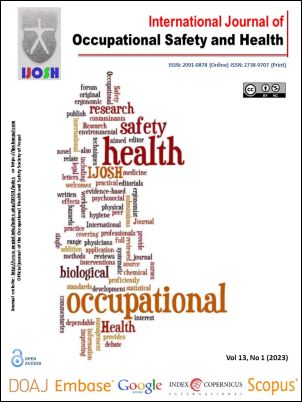Consequence Modeling and Analysis of Benzene leakage and explosion from a poorly sited gas station in the City of Douala, Cameroon
DOI:
https://doi.org/10.3126/ijosh.v13i1.43091Keywords:
Douala, ALOHA, MARPLOT, Poorly sited gas station, BenzeneAbstract
Introduction: Benzene has long been recognized as highly carcinogenic and the most cytotoxic of all air pollutants released by gas stations. Although several studies have been conducted on accidents in the process industry, very little work has been directed toward the modeling of risks caused by the leakage and explosion of toxic substances in gas stations. This knowledge could aid in predicting the vapor concentration inside gas station office buildings and neighboring infrastructures and in developing corresponding safety measures. The purpose of this study was, therefore, to model the consequences of Benzene dispersion following leakage and explosion from gas stations, taking the city of Douala, Cameroon as an example.
Methods: Based on the measured vent emission and meteorological data, the Areal Location of Hazardous Atmosphere (ALOHA v.5.4.7) model was used to predict the hazard radius of leakage and dispersion of benzene from a tank in different seasons. The maps of the toxic and flammable vapor cloud of benzene, evaporation rate from a puddle, and the concentration of toxic and flammable vapor cloud inside and outside of the station were prepared with the aid of MARPLOT and Google Earth software.
Results: The results showed that the maximum average sustained release rate of benzene from a tank was 26 kilograms per minute, with an estimated total amount released of 1,340 kilograms per 60 minutes in the dry season. The puddle spread to a diameter of 19.8 meters. The predicted threat zone distance from the station in the dry season, as compared to the rainy season, had an increase in radius of 12, 20, and 83m for the red, orange, and yellow zones, respectively. The worst hazard level extends primarily in the downwind direction and is predicted to be 31 meters in the rainy season in all directions, covering parts of the adjacent settlements and social infrastructure.
Conclusion: The potential scenarios of benzene dispersion from a poorly sited gas station in the city of Douala have been modeled and the threat zones estimated. Nearby residences and social infrastructures are significantly exposed, with the predicted threat zones being more hazardous for the employees of the gas station. Further research looking at the impact of combined consequences of gasoline emissions may help determine whether the combined effects of benzene with other chemicals are cumulative or synergistic.
Downloads
Downloads
Published
How to Cite
Issue
Section
License
Copyright (c) 2023 Innocent Ndoh Mbue, Samuel Batambock

This work is licensed under a Creative Commons Attribution-NonCommercial 4.0 International License.
This license enables reusers to distribute, remix, adapt, and build upon the material in any medium or format for noncommercial purposes only, and only so long as attribution is given to the creator.





